 Friday - February 06, 2009
Friday - February 06, 2009
Thought to have been the only woman decorated for bravery at sea during the Second World War,RIP.
THIS IS ONE HELL OF A STORY.
ALSO PROVES, AS IF ONE NEEDED THAT, THAT GUYS DON’T OWN THE COPYRIGHT ON BRAVERY.
ALSO SHOWS HOWEVER THAT SADLY, WOMEN DO OWN THE COPYRIGHT FOR BEING SCREWED WITHOUT BEING KISSED.
This is what I am referring to, as you will read.
“it was held that – as a strong swimmer – Coningham had not put her own life at risk, and that the witness to her bravery had helped in the rescue.”
What BS! I think we all can recognize the fact had it been a guy, there’d have been a medal. Anyone seriously doubt that? And what bloody difference does it make that someone helped her. Her act was pure bravery. PERIOD!
Sure wish I’d had the opportunity to know this lady. I think I’d have liked her. There are so many of her generation now passing, with stories untold.
Well, this is her story and I think you might be impressed.
AUDREY ROCHE
RIPAudrey Roche, who died on January 13 aged 90, is thought to have been the only woman decorated for bravery at sea during the Second World War; as a Wren whose ship had been torpedoed, she saved the life of a drowning seaman by giving him her lifebelt, and she was mentioned in despatches.
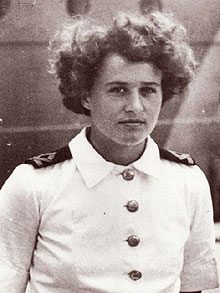
As Third Officer Audrey Coningham, she was one of 1,135 passengers in the 15,000-ton submarine depot ship Medway, which, shortly after 8am on June 30 1942, was torpedoed by Kapitanleutnant Heinz-Joachim Neumann’s U-372 while being escorted by a cruiser and several destroyers from Alexandria to Haifa.
Hundreds of men were thrown into the water along with 47 torpedoes which had broken from their stowage (and were later salvaged and used against the enemy). Audrey Coningham, who had been one of three Wrens on board, swam towards the destroyer Hero, but so many people were crowded around the scrambling nets that she turned and swam towards another ship further off. She had been swimming for between 15 and 30 minutes when she saw two men clinging together. Only one had a lifebelt, and he was supporting the other, whose head kept disappearing beneath the waves.
Even though she did not know how long she would be in the water, Audrey Coningham, who had learned lifesaving at her convent school, managed to pull off her own lifebelt and put it on the drowning man. Leading Seaman Leslie Crossman, who had injured his legs sliding across the barnacles on Medway’s upturned hull, always remembered her words: “Lie still. You’ll be all right. Trust me.”
Audrey Coningham’s selfless act enabled Crossman to stay afloat until he was rescued by a boat. while she swam to the destroyer Zulu, where, after another 20 minutes adrift, she was plucked from the water. The smallest man on board gave up his spare shirt and shorts to dress her.
Despite a recommendation from senior officers on the spot, and the strong, personal support of Admiral Sir Henry Harwood, Commander-in-Chief Mediterranean, for the immediate award of the Albert Medal (since replaced by the George Cross), it took the Honours and Awards Committee in London six months to deliberate. Eventually it was held that – as a strong swimmer – Coningham had not put her own life at risk, and that the witness to her bravery had helped in the rescue.
Instead Coningham was awarded a mention in despatches, and the committee recommended “some publicity”. This blithely stated that she had been swimming in the sea when she came across a drowning seaman. It did not admit that there had been Wrens in Medway or even that the ship had been lost. There were 30 dead from Medway. U-372 was sunk five weeks later by Zulu, and Crossman went on to earn the DSM later in the war and the BEM afterwards, and eventually became a grandfather. Despite the grudging nature of the award, Audrey Coningham wore her Oak Leaf decoration with pride – to the outrage of at least one male officer, who could not believe that she was entitled to it.
Audrey Sylvia Coningham was born on July 12 1918 into a farming family in Sussex. After convent school she went to New South Wales to work as a ranchhand, where she heard that war had been declared. She returned home and joined the WRNS in 1940, becoming a cipher officer. She worked on the staff of the captain of the 1st Submarine Squadron in Alexandria and in Portsmouth, where she rose to second officer.
In 1946 she married David Roche, an officer in the Army in India, where they lived until Partition in 1947. The couple then emigrated to Kenya, packing their two small children and family possessions into an Austin A40 Countryman. They drove through war-ravaged France and Italy, then across the Egyptian desert, and through Sudan and Uganda before arriving in Nairobi in 1951. As a keen golfer, she represented Kenya in international competitions and continued to play into her seventies. The Roches returned to England in 1975, travelling solely by sea, and settled in Wiltshire.
When a reunion was arranged between her and Crossman in 1987, she told him: “I can’t pretend I would have picked you out. You weren’t smiling when we last met.”
In 2003 Audrey Roche opened an exhibition at the RN Submarine Museum, Gosport. On being asked if being in the Wrens was the most important part of her life, she replied: “Good heavens, no. My family is the best time of my life.” She is survived by her five children.
Posted by peiper
Filed Under: • UK • War-Stories •
• Comments (6)
 Thursday - January 15, 2009
Thursday - January 15, 2009
Pictures of Conflict
I’ve seen this pic on several blogs that are covering the Gaza mess. I can not figure out what it is. Doc thinks it might be faked. I think it might be a really high speed photo, but of what? Incoming or outgoing? And that sure looks like one of our Hummers. And what’s up with the kaffiya guy in the foreground, taking a picture?
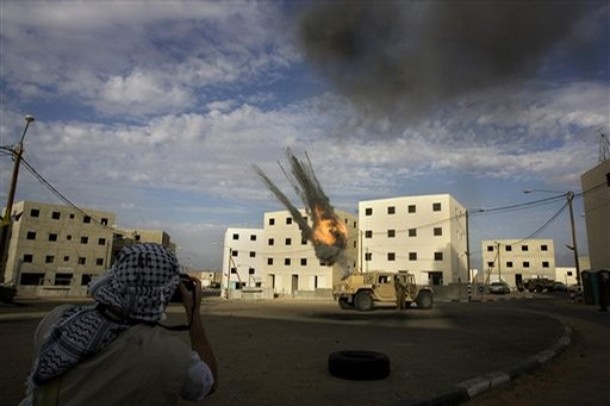
Quite a number of high speed photos available.
I call this sequence “oops, we missed.”

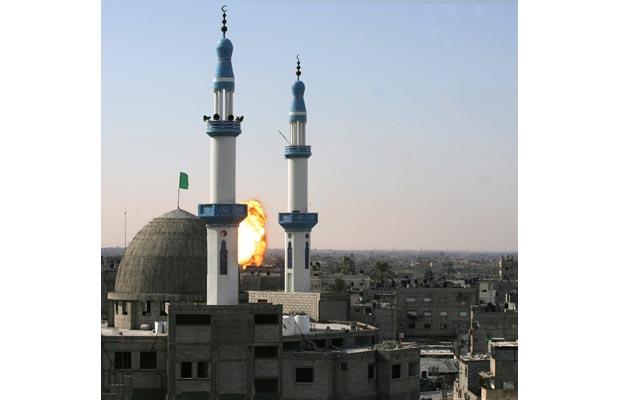

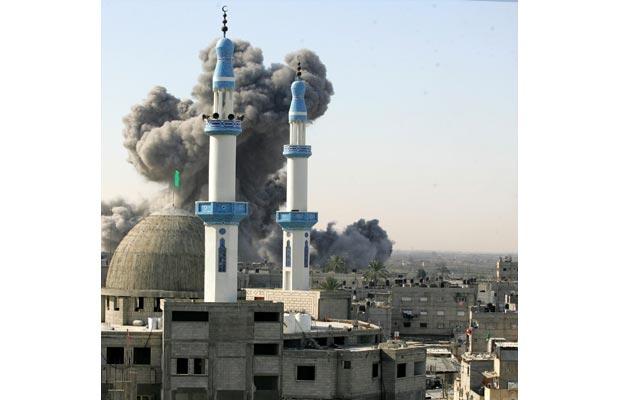
Posted by Drew458
Filed Under: • War-Stories •
• Comments (5)
 Wednesday - January 14, 2009
Wednesday - January 14, 2009
British Troops take out bomb factory in Afghaniland
A Taliban bomb-making factory has been shut down following an airborne assault by British commandos.
Troops seized more than 130 detonators capable of setting off the types of lethal bomb that have killed dozens of coalition soldiers in the last year.
Commanders have hailed the raid as a major success in thwarting the Taliban’s increasingly sophisticated bombing campaign. In the last month 10 British soldiers and seven Canadians have been killed by improvised explosive devices (IEDs) in southern Afghanistan. In a joint operation with Canadian and Afghan forces, troops from 42 Commando Royal Marines swept onto an insurgent stronghold in a helicopter assault.
In the early hours of the morning under cover of darkness, commandos from Kilo Company carried out the attack on the isolated Taliban base to the north of Kandahar City. The Marines swept through compounds and farm buildings as the Royal Canadian Regiment pushed in on foot and in armoured vehicles. Eight suspected bomb-makers were taken prisoner and a Canadian soldier, Tpr Brian Good, 42, of the Royal Canadian Regiment, was killed by a booby-trap bomb in the attack. No Taliban are thought to have died.
But a search of more than 50 compounds and buildings led to seizure of a “huge haul” of lethal weapons and materials used to make IEDs. The troops found bags of shrapnel, from ball-bearings to nut and bolts – all used to maim and kill in “cunningly hidden” underground caches and tunnel, Royal Marine sources said. Six large tubs of explosives were also discovered along with 38 pressure plates used to detonate hidden mines. They also found 3,000 rounds of ammunition, AK47s, anti-personnel mines and 22 rocket-propelled grenades during the raid in the Khakrez and Shah Wali Khot districts that ended last Friday (Jan 9).
The insurgents were also found hiding 20kg of opium with an estimated street value in Britain of £130,000. It is further proof that the Taliban, who are meant to be strict Muslims, are using the drug trade in Afghanistan to finance their attacks. The Americans estimate that the insurgents make $500 million (£330 million) a year from the trade which much of the cash passing to both Taliban and al-Qaeda leaders based in Pakistan.
Posted by Drew458
Filed Under: • Miscellaneous • War On Terror • War-Stories •
• Comments (1)
 Wednesday - December 31, 2008
Wednesday - December 31, 2008
The last Nazi E-boat, which took part in an infamous raid during the Second World War.
Always fascinated by things of this nature and of course anything to do with history never fails to capture my interest.
I hadn’t studied much with regard to these boats. Shame on me. Some interesting technology. I hadn’t ever read about the raid this article refers to. Seems to be a whole lot I don’t know.
BTW ... what makes this raid “infamous” is beyond me. It was war time, it did the job it was design for, there wasn’t any war crime involved. So why infamous?
I’ll wait for Drew to send me the book.
Nazi E-boat saved by military enthusiast
The last Nazi E-boat, which took part in an infamous raid during the Second World War, has been saved by a British military enthusiast.
Last Updated: 3:11PM GMT 31 Dec 2008
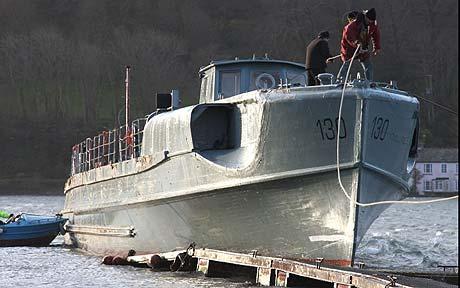
Schnellboot-130, once the fastest vessel in the world, helped attack an Allied convoy off Slapton Sands, in Devon, in a battle in which nearly 1,000 Allied soldiers were killed.
On the night of April 27, 1944, the boat was one of nine German vessels patrolling the English Channel when they stumbled upon Operation Tiger, which was the rehearsal for the D-Day landings.
The convoy launched a raid and killed 946 Allied soldiers. Allied chiefs initially covered up the loss, keen to avoid the enemy becoming aware of what it had achieved or getting wind of any planned invasion of Europe.
After the war the Schnellboot was seized by the British and used to land spies behind the Iron Curtain during the Cold War but was then left in a dockyard and eventually began to disintegrate.
Enthusiast Kevin Wheatcroft has now come to the rescue of the vessel.
Mr Wheatcroft, whose family owns the Donington Grand Prix museum, in Leicestershire, paid just £1 for the hulk but will now spend around £3 million restoring it.
He recently acquired the salvage rights on three sunken Schnellboots off the Danish coast and plans to bring up original parts to help the restoration.
The project will take up to five years after which it is hoped the vessel will become a floating museum and visitor attraction.
Mr Wheatcroft said: “I’ve always been fascinated with Schnellboots and she is one of the most famous.
“The intention is to return her to her original state and into a moving museum.”
He added: “Over the years I have collected a lot of parts including engines, gun platforms, a complete radio and bridge equipment.
“I have acquired salvage rights on three Schnellboot wrecks off the Danish coast. They were sunk after the war in 1948 and 1949, so are not war graves.
“I hope to be able to get an armoured bridge, torpedo tubes and mine racks from the sunken ships.
S-130 was recently lifted from the water and a building will now be put up around her while the work is carried out a few miles along the coast from Slapton Sands.
The Schnellboots were small, fast and effective – and had been devised as a result of the Versailles restrictions set at the close of the First World War.
With the Germans banned from building large warships they embarked on an ingenious naval development programme, resulting in the Schnellboots.
The allies called them E-boats – the “E” standing for enemy.
They were propelled by three powerful Mercedes diesel engines and could travel at 55 knots, faster than any other naval vessel.
The boats had a wedge on the stern that prevented the bow from rising as it accelerated so the guns fired more accurately. That technology is today used on US destroyers.
Wyn Davies, a naval architect and maritime historian, said: “She is the last survivor of a hugely important class of warship that gave our coastal forces quite a headache.
“They introduced several new features, the most useful of which was the use of diesel engines to power them.
“This ended the need for stocking inflammable petrol on board.
“These craft formed the basis for post war development of similar vessels for most Nato navies.”
Posted by peiper
Filed Under: • War-Stories •
• Comments (6)
 Monday - December 29, 2008
Monday - December 29, 2008
Israel pounds Gaza for third day: Interior ministry destroyed.
Early in the morning for some places in BMEWS so thought I’d post this now.
Israel kept up its bombardment of Gaza overnight expanding its targets to include an Islamic university and government buildings such as the interior ministry.
By Tim Butcher in Jerusalem
Last Updated: 8:29AM GMT 29 Dec 2008
Local Palestinian medical sources said six Palestinian children were among the estimated 300 people killed in the attacks, including four sisters aged from 1 to 12 whose house was hit when Israel tried to bomb a nearby mosque.
The night skyline was lit up repeatedly by huge explosions as Israeli F- 16s dropped laser-guided precision munitions on targets inside the densely populated of Gaza City and Rafah.
Witnesses said the Islamic University was struck at least six times and the interior ministry headquarters levelled by bombs.
The ministry was run by Hamas and the university had close links to the Islamist movement.
Israel issued a statement claiming the university labs were used by Hamas as a weapons manufacturing and development centre and it accused university lecturers of teaching bomb-making.
For the first time since operation Cast Lead began on Saturday, Israeli warships got involved, firing naval artillery at positions close to the main port in Gaza City.
Dead and injured Palestinians continued to be brought to Gaza’s hospitals with local medical sources saying the death toll since Saturday had reached 307. The number of injured has climbed to 1,400.
Four girls from the same family aged from one to 12 years old were killed in an air raid in the northern town of Jabaliya that targeted a mosque near their home.
Two boys were killed in raid in the southern city of Rafah, and a seventh person killed was a Hamas member.
With Israel showing no sign of heeding international calls for an end to hostilities the people of Gaza were left guessing what the next range of targets would include.
The centre of Gaza City was plunged into darkness after the local power station stopped functioning because Israel had refused to allow deliveries of diesel oil needed by the generators.
Israel provides most of the power to the Gaza Strip although a local power station, bombed by Israel in 2006 but now partially repaired, provided electricity to Gaza City’s most densely populated area.
The antiquated switching system of Gaza’s power distribution network meant that the power still coming in from Israel could not be diverted to Gaza City so the hundreds of thousands of people got set for lengthy power cuts.
Israel took care to justify the bombing raids on the Islamic University issuing the following statement: “One of the structures struck housed explosives laboratories that were an inseparable part of Hamas’ research and development program, as well as places that served as storage facilities for the organization.
“The development of these weapons took place under the auspices of senior lecturers who are activists in Hamas.
“Among the weapons that have been developed and manufactured at this site are Qassam rockets.
“Hamas has been working tirelessly to extend the range of the rockets, as has been shown during the past few days.”
Israel has repeatedly said the operation could last a long time. The aim is to stop militants in Gaza firing rockets into Israel.
Israel has threatened to launch a ground assault and is now calling up 6,500 army reservists.
An Israeli civilian was also killed this morning by a rocket fired by militants from Gaza. He was hit while working in the centre of the Israeli port of Ashkelon, about eight miles north of the Gaza Strip.
He is the second Israeli to be killed by rocket fire from Gaza since Israel launched the operation.
Posted by peiper
Filed Under: • Israel • Terrorists • War On Terror • War-Stories •
• Comments (6)
 Sunday - December 28, 2008
Sunday - December 28, 2008
U.S. hands over Viagra pills to Afghan warlords in return for vital Taliban intelligence.
I suppose it’s one way to gather information in a war zone.
Does this also mean US Intel. will be contributing to a possible increase in the population of that blighted place?
OK it looks funny. I guess. Maybe. Not too sure. Yeah, it’s funny.
By Mail Foreign Service
Last updated at 12:55 AM on 28th December 2008CIA agents have come up with a potent new weapon in the war in Afghanistan.
Instead of giving local chieftains cash or guns for information about the Taliban, they are supplying them with Viagra.
The anti-impotency drugs are said to have worked wonders for aging tribal chiefs, many of whom have much younger wives.
(WHOA. HOLD THE PHONE. YOUNGER WIVES? HOW YOUNG? MAYBE THIS ARTICLE ISN’T AS FUNNY AS I THOUGHT)
They have greeted returning agents with a mass of information about Taliban movements and supply routes - and a request for more of the little blue pills.In a country where corruption is rife, offering bribes has been standard practice for the U.S. Central Intelligence Agency since the war began in 2001. Agents say warlords and tribal leaders expect to be paid for their co-operation.
School equipment, toys, medicine and even dental care have been offered in return for intelligence on enemy forces.
Cash or weapons were also popular but these often attracted attention from the Taliban, who exacted revenge on villagers for helping coalition troops.
‘If you give somebody $1,000, he’ll go out and buy the shiniest junk he can find, and it will be apparent that he has suddenly come into a lot of money from someone,’ said Jamie Smith, a veteran of CIA covert operations in Afghanistan.
‘Even if he doesn’t get killed, he becomes ineffective as an informant because everyone knows where he got it.’
Mr Smith added: ‘You’re trying to bridge a gap between people living in the 18th century and people coming in from the 21st century.
‘So you look for those common things that motivate people everywhere.’
Which is why CIA field agents turned to Viagra. The drug has been available in the Afghan capital Kabul since 2003, five years after it first became available in the UK.
But the diamond-shaped pills are virtually unknown in many remote villages.
One CIA agent told the Washington Post newspaper the drug was offered only to elderly tribal leaders. Many have the four wives allowed by the Koran, and are persuaded that Viagra will ‘put them back in an authoritative position’, said the agent.
They are all given health checks, to make sure the new excitement will not prove too much for them and turn their families against the U.S.-led coalition.
Posted by peiper
Filed Under: • RoPMA • Terrorists • War On Terror • War-Stories •
• Comments (2)
 Tuesday - December 16, 2008
Tuesday - December 16, 2008
ONE HELL OF AN AMERICAN THAT MAKES ME SO DAMN PROUD HE WAS OURS! RIP, Major Robert Furman.
This is in The Telegraph today.
How many American papers have told his story? Has it been on TV back home? I sure hope so.
Did this story at least make the papers in NJ? NY? CT? I have no idea why this is so late in coming as he passed away two months ago. But better late and learn about this guy then never know at all. Damn it that was one hell of a generation! What happened to us?
Major Robert Furman
Wartime intelligence officer charged with discovering the true extent of the German nuclear threat .
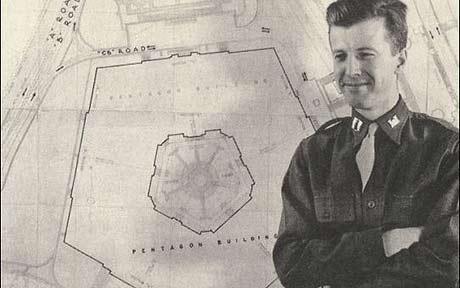
Robert Furman, civil engineer who helped to oversee the construction of the Pentagon and then played a clandestine role in the Manhattan Project. Photo: US Department of Defence.
Major Robert Furman, who has died aged 93, oversaw the construction of the Pentagon and played a vital part in the American struggle for nuclear supremacy when, in 1943, he was ordered to discover how far the Germans had advanced in developing the atomic bomb.
He began by interviewing scientists on campuses across the United States and was appointed the personal handler of Niels Bohr, the Nobel prizewinner who had worked on the understanding of atomic structure and had recently escaped from occupied Denmark. Furman was particularly impressed by the ability of Bohr and his associates to play chess without using a board.
Furman’s next task was to organise collection of water samples from the Upper Rhine and Lake Constance to check for evidence of German nuclear activity. After a failed attempt to kidnap the senior German scientist Werner Heisenberg, Bohr’s former assistant, he sent Moe Berg, a former baseball player for the Boston Red Sox among others, to hear Heisenberg address a scientific conference in neutral Switzerland. Berg was given a pistol to shoot him if he indicated that the Germans were working on a nuclear bomb and a cyanide capsule for himself in case the assignment failed. But after hearing Heisenberg’s talk, and then dining with him, Berg reported that he could find no evidence to support such suspicions.
As the Allied armies advanced across Europe, Furman ran Operation Peppermint, in which he led a team which searched for all existing uranium stocks, needed for nuclear fission. This involved his coming under German sniper fire in Belgium. But he eventually found a stockpile of 31 tons near Toulouse, which was duly dispatched to the United States. He also rounded up Heisenberg and nine other scientists; they were held at Farm Hall, Godmanchester, near Cambridge, to ensure that they did not end up in the Soviet Union.
When Germany surrendered Furman escorted a large consignment of uranium aboard the cruiser Indianapolis from the secret Manhattan Project at Los Alamos, New Mexico, to Tinian island in the Pacific. Four days after the cargo was discharged the ship was torpedoed, with the loss of 800 sailors’ lives.
From Tinian, Furman watched the B-29 Enola Gay take off to drop the first atomic bomb on Hiroshima. Later he visited Japan, but he continued to believe that the two atomic bombs had ensured that the Cold War “remained cold”.
The son of a bank teller descended from an immigrant who left Stoke-on-Trent in the early 18th century, Robert Ralph Furman was born on August 21 1915, at Trenton, New Jersey. He grew up a keen tennis player. On leaving Trenton High School he studied Civil Engineering at Princeton, where he joined the Reserve, then worked for the Pennsylvania railroad and the Turner construction company in New York.
After being called up in 1940 he was commissioned as an artillery officer with a horse-drawn unit and transferred to the Quartermaster Corps’ construction division. It was there that he attracted the attention of Colonel Leslie Groves, who was in charge of constructing the new War Department building in Washington, to be known as the Pentagon.
Groves appointed Furman the third-ranking supervisor of the project, but he soon took the major role, with responsibilities that ranged from the materials used to the 123,000-strong workforce. His duties involved staying overnight once a week to walk round the whole building, when he would stop workers on the night shift drinking on the job.
After 17 months the job was finished, and Furman was invited by Groves – who was by now a major-general and military director of the Manhattan Project – to become his chief of foreign intelligence.
When Furman left the Army in 1946 he settled at Bethesda, Maryland, and started a construction business building houses, schools, churches and offices, including the American embassy in Nicaragua.
He became a pillar of his local community, serving as an active president of the Rotary Club and becoming a member of the chamber of commerce and of his local Episcopalian church. He also sang baritone in a barbershop quartet.
For decades his role in the development of the atomic bomb was cloaked in secrecy, with his name eliminated from so many official documents that he was known to historians as “the mysterious major”.
His neighbours knew him to be a private man who was proud to have served in the war, but they were astonished when, in his last years, he appeared in a television programme about the Manhattan Project.
Recognising the growing interest in events that were receding from the public memory, he agreed to give a conducted tour of his old office in the Pentagon which, little changed in 60 years, now houses the Bureau of Verification and Implementation, which tracks arms control measures. Last December he took part in a seminar at the State Department on the atomic bomb.
Robert Furman died on October 14. He married, in 1952, Mary Eddy, who had worked for the Office of Strategic Services during the war. She survives him with their son and daughter and two daughters from her previous marriage.
Hey .. is it just me or did the uniforms look better in his day then in the present time? Seems that way.
Posted by peiper
Filed Under: • History • News-Briefs • Patriotism • War-Stories •
• Comments (2)
 Sunday - November 16, 2008
Sunday - November 16, 2008
Iraqis accused of murdering British troops get thousands of pounds in legal aid .
Thought this whole thing rather Moonbat like although maybe not bizarre given today’s legal system.
Bet the Brit taxpayer really happy to fund this. yeah right.
gotta go, running behind. Hope I can post more later.
Reinforces the thought, First we kill all the lawyers.
By Sean Rayment, Defence Correspondent, and Ben Leach
Last Updated: 10:42PM GMT 15/11/2008Two Iraqis accused of murdering British prisoners of war have been granted thousands of pounds in legal aid to fight being handed over to the Iraqi authorities to face trial.
Faisal Al-Saadoon and Khalaf Mufdhi are accused of killing Staff Sergeant Simon Cullingworth and Sapper Luke Allsopp in cold blood during the beginning of the Iraq war in 2003.
The British government wants to hand the two Iraqis over to the Iraqi government for trial. But their British lawyer has launched a High Court legal challenge saying such a trial would breach his clients’ human rights.
If he succeeds, the men, who are currently in British custody in Iraq, could be brought to the UK to face trial. Senior British Government officials are concerned that the two men will claim political asylum if they are tried in the UK.
The challenge, to be heard this week, has angered the dead British soldiers’ relatives and opposition politicians.
Patrick Mercer, the Tory MP for Newark and a former infantry commander, said: “ It seems totally wrong to me that these men are being given legal aid. Would we have given legal aid to Nazis who committed war crimes in the Second World War – of course not – this is arrant nonsense.
“What the hell is the point of fighting a war to try and establish democracy in a tyranny and then show a complete lack of trust in the new regime by failing to deliver alleged killers for trial? If these men do not stand trial in Iraq it would make a mockery of the blood spilt by British troops in fighting this war.”
The murder of SSgt Cullingworth, 36, and Spr Luke Allsopp, 24, both members of 33 Engineer Regiment (Explosive Ordnance Disposal) provoked a storm of outrage in the UK, with Tony Blair claiming that the two men had been executed by the Iraqi Army.
The soldiers were travelling as part of a convoy which was ambushed by Fedayeen militiamen on the outskirts of the town of Al Zubayr in southern Iraq on March 23, 2003.
While half the convoy escaped, SSgt Cullingworth, who was married with two sons, and Spr Allsopp, were taken to a local Ba’ath party headquarters and then to an Iraqi intelligence base, where they were shot dead.
Photographs taken of the soldiers at the compound as they lay dying, surrounded by a baying mob of Iraqis, were later shown on the Arabic TV channel al-Jazeera. The soldiers’ graves were discovered a month later and their bodies were exhumed.
The judicial review of the men’s case has been launched by the firm Public Immunity Lawyers who have been funded through legal aid.
Phil Shiner, of Public Immunity Lawyers, believes that Mr Saadoon, 56, and Mr Mufdhi, 58, would not get a fair trial in Iraq and could face the death penalty if found guilty. He also believes they would be tortured and abused by other inmates.
Mr Shiner told The Sunday Telegraph that the Iraqi Higher Tribunal, where they would be tried, was a “politicised court” established by the US-led coalition to try senior members of the former Ba’athist regime, and had already ordered the execution of several regime members including Saddam Hussein.
Mr Shiner, who confirmed that the judicial review was being funded by legal aid, will claim that to try the alleged killers in Iraq would be a breach of their human rights under the Article 3 of the European Convention of Human Rights.
He said: “The IHT have a track record of sentencing people to death and we, the UK, have a policy of not handing over people to a jurisdiction if there is a risk of the death penalty being applied.”
The Sunday Telegraph understands, however, that senior officials in the Ministry of Defence, the Foreign Office and the Ministry of Justice have been given assurances at the “highest level” that the two accused will receive a fair trial and treatment, whatever the outcome of the case.
It is also understood that one of the families of the British dead have written to the Iraqi court and asked for clemency in the event that the former Iraqi soldiers are found guilty.
(proves there’s ALWAYS one out there, doesn’t it?)
Margaret Cullingworth, 83, the mother of Simon Cullingworth, who lives in Ruthin, North Wales, said: “They should be tried and brought to justice in their own country. It was a horrible crime. We could have accepted it if they had been killed in battle but they were prisoners and were murdered.
“We do have confidence in the UK authorities and believe they will do the right thing. Simon’s widow has been left to bring up the children on her own and she has found it very hard – we all have.”
A spokesman for the MoD said: “The Secretary of State for Defence and the Foreign Secretary have received assurances from the Iraqi Government that Mr Al-Saadoon and Mr Mufdhi will be treated humanely when they are transferred to Iraqi custody. The assurances have been considered and found credible, and they have agreed that the two suspects can be transferred to the Iraqi authorities, provided that the UK courts finds this lawful.
Posted by peiper
Filed Under: • Terrorists • UK • War On Terror • War-Stories •
• Comments (1)
 Saturday - November 15, 2008
Saturday - November 15, 2008
The first colour photographs from the German front line during World War One.
A bit of interesting photographic history.
My posting will be light to non today.
There are 17 color photos at the link.
Hans Hildenbrand was one of 19 official German photographers documenting the war, but the only one to shoot in colour
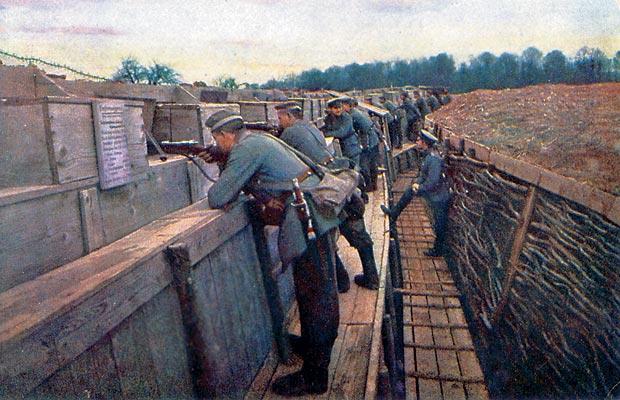
Hildenbrand’s photos are mostly from Alsace and Champagne in 1915 and 1916
Picture: HANS HILDENBRAND
Here is the link to the other pictures.
Posted by peiper
Filed Under: • Blog Stuff • History • War-Stories •
• Comments (17)
 Wednesday - October 29, 2008
Wednesday - October 29, 2008
NEVER JUDGE A BATTLING BRIT BY THE COVER. THEY COME IN MANY FORMS, AND THEY WILL GET YA.
THIS BATTLING BRIT DIDN’T DO IT IN A SPITFIRE OR ON THE BATTLEFRONT WITH A RIFLE.
TOO OFTEN WE FORGET THAT THERE ARE MANY WAYS OF SERVING YOUR COUNTRY THAT CAN BE JUST AS LIFE THREATENING.
This woman’s life was spent doing a James Bond for real. Can you imagine the stress? I can’t see how there wouldn’t be. I guess she had nerves of steel. If not that, then something else and whatever it was, she was extraordinary.
RIP and Thanks, Miss Julia Pirie.
Julia Pirie
Last Updated: 8:48PM GMT 28 Oct 2008
Julia Pirie, who has died aged 90, spent two decades as an MI5 agent at the heart of the Communist Party of Great Britain, most of it as personal assistant to the party’s general secretary.
A small, dumpy woman with the appearance of a confirmed and rather matronly spinster, Julia Pirie was the most unlikely of spies. But her unassuming demeanour masked a sharp intellect and the powers of observation essential for the task of a secret agent.
She was recruited to infiltrate the party at the beginning of the 1950s, at a time when many Britons still remembered the Soviet Union as a valued wartime ally and Communists retained considerable influence within the trades union movement.
Julia Pirie would pass over her regular reports and photocopied documents to her MI5 handlers during cricket matches at the Oval cricket ground, a procedure that left her with a lifelong love of the game.
She was told to resign from her party post in the 1970s, by which time, she said, the Communist Party had become a rather pathetic and increasingly irrelevant organisation. She went on to collect intelligence on the Provisional IRA during several missions in Europe.
Effortlessly adopting the cover of a harmless, elderly English spinster intent on sightseeing, Julia Pirie once travelled to Barcelona, renting a flat immediately below one occupied by IRA officials. The flat, rented by members of the Catalan terrorist group Terra Lliure, was being used by the IRA as a safe house and a temporary store for shipments of gold bullion supplied by the Libyan President Colonel Muammar Gaddafi.
Julia Pirie’s inability to control the reverberation and echo coming from her own equipment led to some precarious and alarming moments. At one point her apartment was raided by the Barcelona police, putting the entire operation at risk. Julia Pirie was aware from monitoring their communications that the IRA terrorists were nervous of discovery, and the arrival of a number of armed police officers was unlikely to reassure them.
But she managed to persuade the police that she was simply an innocent English spinster, and calmly continued her monitoring operation until her MI5 handlers, alarmed at the latest turn of events, pulled her out for her own safety.
Elizabeth Mary Julia Pirie (known to her family as Elizabeth, but, later, as Julia to her colleagues in MI5) was born at Harbury, Warwickshire, on July 8 1918, the only daughter of Allen Grant Pirie and Elizabeth Mary Pirie. Her father, an advocate from Aberdeen, died in 1923 as a result of wounds received in France while serving in the Royal Warwickshire Regiment. Soon afterwards Elizabeth’s mother decided to return to Calcutta, where she had been born and brought up, taking her daughter with her.
Elizabeth was educated at the Loreto convent at Shillong, in a rural area of Assam, where she recalled tigers roaming around the school. On the outbreak of war in 1939 she returned to Britain, determined to join the war effort. She joined the Auxiliary Territorial Service (ATS), the women’s section of the British Army, and saw service as a driver of staff cars and ambulances in Shrewsbury before volunteering after D-Day for work in France and Germany.
She was among the first Allied soldiers to enter Bergen-Belsen concentration camp, and would later speak movingly about the effect this experience had on her.
After serving with the British Army on the Rhine, she left the Army and went to work as secretary and personal assistant to Kitty, Duchess of Atholl, who, as chairman of the British League for European Freedom, was an ardent campaigner against Soviet control of eastern Europe. It was during this time that Elizabeth Pirie joined the First Aid Nursing Yeomanry, which had provided female agents for the Special Operations Executive working with the French Resistance.
She then worked for the International Maritime Organisation before being approached by MI5, possibly as a result of her links with FANY, and asked to infiltrate the Communist Party of Great Britain working as a typist. She worked for F4, the section within MI5 which monitored the Communist Party’s activities and its links with the trades union movement.
Given her position as personal assistant to the general secretary, John Gollan, it seems highly likely that one of Julia Pirie’s earliest coups was to provide information that allowed MI5 to obtain the entire secret membership of the party. Selected members of the party were told to keep their membership secret so that they could be used by the KGB or Soviet military intelligence (the GRU) in operations in Britain.
Peter Wright, a former senior MI5 officer, revealed in his book Spycatcher that in the late 1950s one of the F4 agent handlers obtained details of the location of the secret membership files from an agent inside the party. The files were stored in the Mayfair flat of a wealthy party member, and the property was put under blanket surveillance. When the owner’s wife rang him to say that she was going out for an hour, but would leave the key under the doormat, an MI5 officer swiftly went round to take an impression.
Armed with the key, MI5 simply waited until the occupants went away to the Lake District for the weekend, then let themselves in and copied the secret files, rendering the potential Soviet agents useless. This was Operation Party Piece, one of a number of operations against the Communist Party that led Wright to claim: “For five years we bugged and burgled our way across London at the state’s behest while pompous bowler-hatted civil servants pretended to look the other way.”
Wright also described how bugging the party’s King Street headquarters was made more difficult by the way in which the leadership constantly changed the location of key meetings, eventually moving them to a windowless basement room.
An agent inside the building tipped off F4 to the location of the room and said that an old coal chute led down to it from the pavement. The response was another MI5 coup, known as Operation Tie Pin. This took place on a Saturday night when no one was likely to be in the party headquarters. The entire staff of MI5’s “A” branch surveillance team, known as “the Watchers”, was carefully choreographed to play the part of drunken revellers walking past the building in different directions, disguising the noise as an MI5 technician surreptitiously placed a false door containing a bugging device over the chute to allow continued monitoring of the meetings.
As personal assistant to the general secretary, Julia Pirie would certainly have been aware of the change of location for the secret meetings and remains the most likely source of the MI5 tip-off.
But within the Communist Party she was completely trusted, accompanying the general secretary to regular meetings and conferences behind the Iron Curtain. The fact that she usually attempted to avoid these “dreary” visits to the Eastern Bloc only reinforced her cover.
Despite the “threat within” that the party was believed to be, Julia Pirie revealed to her handlers that Gollan had very little power and was entirely beholden to Moscow and the Communists within the trades unions.
The Soviet intervention in Hungary in 1956 was the catalyst for a loss of party members that was to increase with the suppression of the Prague Spring in 1968. Gollan responded to the Soviet invasion of Czechoslovakia by saying: “We completely understand the concern of the Soviet Union about the security of the socialist campe_SLps we speak as true friends of the Soviet Union.” With membership plummeting, from 56,000 during the Second World War to 20,000 by 1978, Julia Pirie was pulled out.
After retiring from active operations in the 1990s, she lectured to groups of MI5 trainees and the police before indulging her love of travel, visiting Russia, Europe, Africa, Australia, the Caribbean and the United States.
She remained extremely generous with her time and her commitment to those she regarded as her close family, regularly keeping in touch with relatives of all ages.
Despite the intense pressure of working under cover for much of her life, she always retained her quiet sense of humour and warm laugh. She never lost her keen interest in sport, particularly cricket, and was an avid and skilled bridge player.
Until her death on September 2 Julia Pirie continued to receive her pension from the Communist Party, paid monthly into her account from a bank in Italy. She was unmarried.
MI5 agent who for two decades worked at the heart of the British Communist Party
Posted by Drew458
Filed Under: • Patriotism • UK • War-Stories •
• Comments (1)
 Saturday - October 25, 2008
Saturday - October 25, 2008
French accuse English of war crimes and exaggeration over Agincourt, (593 years ago. ahhhhhh)
OKAY ... BACK TO SCHOOL TO LEARN THE FRENCH VERSION .... ANY BRITS LURKING OUT THERE? NAUGHTY BRITS. NAUGHTY. SAY SORRY TO THE FRENCH IMMEDIATELY. LOL BRITS STILL GET UP FRENCH NOSE AFTER ALL THIS TIME. THEY’LL NEVER FORGIVE YA WATERLOO EITHER.
French accuse English of war crimes and exaggeration over Agincourt
The French are using the anniversary of the Battle of Agincourt to accuse England’s men of acting like ‘war criminals’.
By Peter Allen and Nabila Ramdani in Agincourt
Last Updated: 6:19PM BST 24 Oct 2008
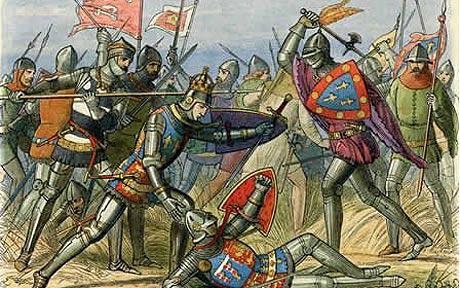
Exactly 593 years after King Henry V’s legendary victory, a revisionist conference will be held at the scene of the triumph.
Academics will suggest that the extent of the feat of arms was massively exaggerated, with claims that the English were hugely outnumbered a lie.
More controversially still, they will say that the foreign invaders used numerous underhand tactics against an honourable enemy.
These included burning prisoners to death and setting 40 bloodthirsty royal bodyguards on to a single Gallic nobleman who had surrendered.
‘There’s been a distortion of the facts and this conference will attempt to set the record straight,’ said Christophe Gilliot, a distinguished French historian who is director of the Medieval History Museum in Agincourt, where the conference will take place.
‘We have historians arriving from all over France, and all will produce hard facts concerning the battle, rather than rumours and speculation.
‘At the very least the English forces acted dishonourably. The middle ages were a very violent time, of course, but some might accuse the English of acting like what might now be called war criminals.’
It was on Friday October 25 1415 - St Crispin’s Day - that a force led by Henry V engaged the French at Agincourt, a small village not far from Calais in northern France.
The English army, made up mainly of archers using longbows, massacred a vast force of noblemen in the most famous battle of the Hundred Years’ War.
Immortalised by William Shakespeare in his play Henry V, Agincourt has since become a byword for English heroism in the face of apparently insurmountable odds.
In fact, detailed bureaucratic records of French king Charles VI’s army reveal that they were made up of 9000 travelling soldiers, perhaps with another 3000 locals from the Picardy region where the battle took place.
This compares to the total force of 12000 who travelled to France with Henry, although some 3000 were lost during the preceding siege of Harfleur, and through dysentery.
English chroniclers writing in the years following the battle have wrongly claimed that there were as many as 150,000 French, compared to 6000 odd English.
Mr Gilliot said notably horrific acts perpetuated by the English included placing prisoners in a barn and setting in on fire, with the permission of Henry V.
When the Duke of Alençon, who commanded the second division of the French army, had failed to put an axe through Henry, he tried to surrender but was killed by the King’s 40-strong bodyguard.
Mr Gilliot said: ‘There were numerous heroic acts by the French on the field of battle, but they were met with barbarism by the English.’ While, significantly, no English academics have been invited to today’s conference in France, the revisionist theories have found support on the other side of the Channel.
Professor Anne Curry, a military historian from Southampton University, admitted that many accounts of the battle have been exaggerated to give the impression of “plucky little England” against the evil French.’
Professor Curry, author of ‘Agincourt: A New History’, added: ‘For the French, Agincourt was such a disaster that someone had to be blamed. For the English, it afforded an opportunity to eulogise Henry and his army.’
Posted by Drew458
Filed Under: • History • News-Briefs • UK • War-Stories •
• Comments (18)
 Monday - October 13, 2008
Monday - October 13, 2008
New Yon
New Dispatch up from Michael Yon, from Afghanistan. Go. Read. Savor. Learn. Donate.
The Road To Hell finds Michael going off without his watchers, out to the Line and beyond, for his latest report. The photos alone are stunning - Afghanistan is such a dump it makes Palestine look good. But, as always, it’s the story that you want to read.
Posted by Drew458
Filed Under: • War-Stories •
• Comments (0)
 Saturday - September 27, 2008
Saturday - September 27, 2008
Fighter pilot who proved one of the finest American combat leaders of the Second World War .
Recently I am aware we’ve been criticized for so much foreign posting on what is after all, an American blog site.
I might have more to say on the subject later but here is a Brit obit in a major paper on an American pilot of WW2. I was never aware of this fellow. Were any of you? Did any major American paper give this guy this sort of coverage? We just don’t tend to do it this way back home. And that’s a shame really because there have been many people, ordinary folks, who once had lives and achieved things of note and then got on with living and raising families and never talking about the past. Then after they’re gone we learn about them and they turn out to be quite fascinating. But they were never famous in their own time and did not seek fame.
I post a lot of things here that are to do with things Brit or European. (I never thought of Brits as European. Never will and wife’d divorce me if I did)
I had hoped that seeing what’s happening here might wake up ppl at home. Not that anyone here is asleep. But I did think folks might be interested in how we’re covered in the press here, as well as the totally screwed up and stupid PC culture that prevails. And when it comes to PC stupid, the left here takes first prize. So far anyway. My next post of nanny statery will be beyond belief.
OK so here .... The obit for an American fighter ace. One of his pilots described Blakeslee as “George S Patton Jr in a P-51 Mustang”.
And damn it ... wouldn’t it have been something to be able to have known this guy and listened to his war stories. If he’d have talked about them.
Colonel Don Blakeslee
Fighter pilot who proved one of the finest American combat leaders of the Second World War .
Last Updated: 10:27PM BST 26 Sep 2008

Colonel Don Blakeslee in his RAF Spitfire: he later flew Mustangs from Debden, Essex, as commander of the 4th Fighter GroupColonel Don Blakeslee , who has died aged 89, served in the Royal Canadian Air Force and the RAF before transferring to the USAAF, where he was considered one of the finest combat fighter leaders of the Second World War.
On January 1 1944 Blakeslee was appointed to command the 4th Fighter Group based at Debden, Essex. The role of the Group was to escort the Eighth Air Force’s long-range bomber force deep into enemy territory. A forceful, no-nonsense man, Blakeslee left his pilots in no doubt of what he expected of them when he addressed them for the first time: “We are here to fight,” he began. “To those who don’t believe me, I would suggest transferring to another Group. I’m going to fly the arse off each one of you. Those who keep up with me, good; those who don’t, I don’t want them.”
His Group was equipped with the P-47 Thunderbolt, a fighter he had little time for. He worked hard to be re-equipped with the P-51 Mustang, and when this was approved he was told that his pilots had to be operational within 24 hours of receiving them. He agreed, instructing his pilots to “learn how to fly them on the way to the target”.
In March 1944 Blakeslee led the first Mustangs over Berlin, escorting a daylight-bombing raid. In just four months his aggressive leadership led to the Group’s achieving its 500th “kill”. On June 21 he led his fighters (known to the bomber crews they escorted as their “little friends”) on the first “shuttle” bombing mission to Russia by Eighth Air Force Flying Fortresses, a flight of 1,470 miles. Blakeslee and his pilots landed in Ukraine after seven hours in their single-engine fighters.
By his own admission Blakeslee was not a very good shot, and he flew very close to his adversary before opening fire. He was credited with 15 and a half victories, but when there was a multiple claim he always allowed junior pilots the credit. Many believe that he destroyed at least 30 enemy aircraft.
His greatest asset was his outstanding ability as a leader in the air. One eminent aviation historian wrote: “He was everywhere in the battle, twisting and climbing, bellowing and blaspheming, warning and exhorting. His ability to keep things taped in a fight with 50 planes flying at 400mph was a source of wonder.” One of his pilots described Blakeslee as “George S Patton Jr in a P-51 Mustang”.
Blakeslee forged the 4th Fighter Group into one of the most formidable and successful USAAF fighter combat units — many claim it was the best. By the end of the war it had become the top-scoring American fighter Group. Having flown more than 400 operational sorties since transferring to the USAAF, he was finally grounded in September 1944.
Donald James Mathew Blakeslee was born on September 11 1917 at Fairport Harbour, Ohio. As a boy he watched the Cleveland National Air Races and became fascinated by flying. In 1939 he and a friend bought a light aircraft, but when his friend crashed it Don left Ohio, in October 1940, to join the RCAF.
After completing his training he arrived in England in May 1941, joining No 401 (RCAF) Squadron, flying Spitfires from Biggin Hill. Engaged on sweeps over northern France throughout 1941, he was credited with destroying a Messerschmitt Bf 109 and damaging others. He also destroyed two aircraft on the ground during strafing attacks.
He later transferred to No 133, one of the three American-manned “Eagle” squadrons of the RAF, and during the Dieppe operation in August 1942 he shot down a Dornier bomber, probably destroyed a Focke Wulf 190, and damaged two others. He was awarded a DFC after completing 120 operations.
In September the Eagle squadrons were transferred with their Spitfires to the USAAF’s 4th Fighter Group, and Blakeslee took command of the 335th Squadron. The unit was soon re-equipped with the P-47, and in April 1943 he achieved the aircraft’s first success when he shot down a FW 190, followed shortly afterwards by a second. In May he was promoted to lieutenant-colonel and became the Group’s executive officer, continuing to fly in combat. As one of the most experienced American fighter pilots in Europe, he was asked to lead the recently arrived 354th Fighter Group on its initial operations. This was the first unit to be equipped with the P-51 Mustang, and he was able to claim another victory on the type. His experience with the 354th convinced him that the Mustang was superior to his own unit’s P-47s. A few weeks later he was promoted to colonel to command the 4th Fighter Group.
After he was grounded, Blakeslee returned to the United States to command an airfield in Florida. He remained in the USAAF and commanded a fighter wing. His later assignments included two tours in Germany and one in Korea, at HQ Tactical Air Command.
He saw service in Vietnam and retired from the Air Force in 1972 , when he went to live in Florida.
Blakeslee was one of America’s most decorated pilots: he was twice awarded America’s Distinguished Service Cross, as well as a Silver Star and numerous other medals.
Most fighter pilots enjoyed playing the role, sporting artwork on the noses of their aircraft as well as the tally of their scores. But for all his aggression and flamboyance in the air, this was not Blakeslee’s style. His aircraft bore no artwork and no “victory” crosses beneath the cockpit.
In later years, many aviation artists chose to paint a particular ace’s finest moment, usually an event relating to one of their air combats. The only painting Blakeslee ever officially approved was one that shows him standing in front of his Mustang pointing to his watch as he stands alongside a Russian officer. It depicts his arrival in Ukraine after his unique flight in June 1944 when he led the 4th Fighter Group across Germany and Eastern Europe using only a map on his knee and a watch.
He was greatly admired in the American fighter pilot community, which recognised him as one of the two outstanding pilots in the European theatre, the other being Colonel “Hub” Zemke.
In retirement Blakeslee was a private man who shunned publicity; but in July 2001 he agreed to visit Duxford with three other American “aces” for the Flying Legends Show.
Don Blakeslee died on September 3. He married his wife, Lee, on his return to the United States in 1944. She predeceased him, and he is survived by their daughter.
Posted by Drew458
Filed Under: • War-Stories •
• Comments (3)
 Wednesday - September 24, 2008
Wednesday - September 24, 2008
A harrowing account of her time in a Japanese prisoner of war camp. (one hell of a brave woman. RIP)
Heck of an item to start the morning blog with but this is a must. I booted without even checking emails first, which I normally do.
No Brit I bet outside this woman’s family and perhaps friends, knew her story. She wasn’t the only very brave lady to face this ordeal to be sure.
But this happens to be her story, and I want to share it with all of you. I’ll be quite honest about it. I can’t say with absolute certainly and no doubts whatever, that I’d have had what it took to survive the same ordeal. Who can predict until faced with it?
Don’t forget as well, this was a generation of women who could take for granted that no matter what, men would do all they could to protect them. And even at worst, women and especially nurses wouldn’t be slaughtered like cattle by soldiers. Rape was always a possibility of course. But these women must surely have been brought up short and taken much by surprise at the mindless cruelty of the Japanese soldier against unarmed women who were never even combatants. For example ....
In her book “Sisters in Arms, Brit nurses tell their story” by Nicola Tyrer, she recounts an episode where a group of British nurses were captured after wading ashore when their ship was sunk. The Japs then forced the women back into the water, whereupon they opened fire on them killing almost all. When the Japs left, a few survivors made in back to shore and one of them had a bullet go clean through her. She somehow survived the war and also was able to hide her injury from another Japanese patrol who later captured the few nurses who survived the original shooting.
So then .... Mrs. Phyllis Thom ... age 100 .... A testament to bravery .... RIP .... From a most respectful Yank.
Phyllis Thom
Nurse who produced a harrowing account of her time in a Japanese prisoner of war camp after the fall of Singapore.
Last Updated: 2:06AM BST 24 Sep 2008
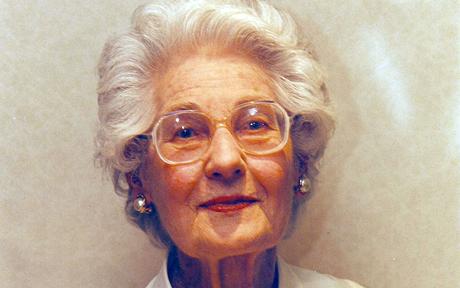
Phyllis Thom: in the camp, kept her spirits up by singing hymnsPhyllis Thom, who died on September 6 aged 100, was a nursing sister caught up in the Japanese invasion of Malaya in December 1941; the diary she kept of her three-and-a-half year internment, now in the Imperial War Museum, is all the more harrowing because of its abbreviated nature.
At the beginning of December 1941, Phyllis Briggs, as she then was, was one of four nursing sisters at the General Hospital in Alor Star, North Malaya. On December 8 her life of parties, dances and boat trips was rudely shattered by the arrival of Japanese bombers, followed soon after by troops crossing the Malayan border.
All the European women were evacuated, except for the hospital staff, who remained another four days to discharge the patients. On December 12, the nursing sisters were given the password “Curtain fallen” and joined the convoy south, travelling along roads jammed with refugees and dotted with burnt-out cars and rickshaws.
In January, Phyllis Briggs was evacuated to Singapore and assigned to a maternity hospital now used for air raid victims.The sight of a Chinese woman with half her face blown away and maggots crawling out of what was left of her nose was one she never forgot.
On Friday February 13 1942, as the Japanese bombardment intensified, she boarded the Mata Hari, a cargo ship with accommodation for nine passengers which sailed out of Singapore harbour with 320 aboard. There followed a hair-raising voyage, during which the ship had to dodge attacks by Japanese bombers. Two vessels that had been in Singapore harbour at the same time, the Kuala and the Vyner Brooke, were sunk. But as dawn broke on the third day, the Mata Hari was spotted by a Japanese destroyer and there was no option but to surrender.
Put ashore on the island of Banka and separated from their menfolk, the women and children were detained overnight on a jetty without food or water, huddling together to keep warm. As Japanese soldiers wrenched off rings, watches and other valuables, Phyllis Briggs knotted the jewellery she had into a head scarf and tied it under her hair for safety. It was to prove invaluable later as a means of bartering for food and medicines.
The following day they were transferred to a makeshift camp at Muntok, originally built for coolies in the tin mines, comprising a number of windowless stone buildings with sleeping accommodation consisting of raised concrete platforms, and rudimentary sanitation.
There they were joined by the survivors of other captures and sinkings, including Vivian Bullwinkel, the only survivor of a group of 22 Australian nurses who had waded ashore to the island after the sinking of the Vyner Brooke, and were massacred by Japanese soldiers.
Over the next three and a half years Phyllis Briggs was moved from camp to camp, enduring hunger, illness, the loss of friends, and arbitrary cruelties meted out by Japanese guards. At Palembang, Sumatra, she became seriously ill, passing blood, and nearly died.
Yet twice a day she had to line up for a roll call, a ritual known as “Tengko” (the answer required from prisoners): “We had to bow to the guards as they came by. If we did not bow low enough we would get a face slap”. Ration lorries came up the hill every day and the food, often rotten and full of weevils, was thrown on the road. “The best rations came on the Emperor of Japan’s birthday: four prawns each, one banana and a piece of pineapple!”
Phyllis Briggs did what she could to help the sick and dying. To keep her spirits up she joined a choir and sang hymns, a favourite being The Captive’s Hymn, written by her fellow internee, Margaret Dryburgh: “Father in captivity/ We would lift our prayer to Thee./Keep us ever in Thy love/ Grant that daily we may prove/ Those that place their trust in Thee,/ More than conquerors may be.”
Margaret Dryburgh died on April 21 1945 aged 54. The story of the choir inspired the film Paradise Road (1997), with Pauline Collins as Margaret Dryburgh.
By 1944 death had become an everyday occurrence, and entries from Phyllis Briggs’s diaries of the time convey the mixture of tragedy and black comedy that were characteristic of camp life.
“May 3 1944: Mrs Colley ill. Mrs MacLelland died. May 11: Mrs Curran Sharp died. I ate chopped banana skins for the first time, which helped to fill a corner. Every day fresh orders from the Japs about gardening and grass cutting. July 4: Felt ill and fainted again. The Japs complain that the children pull faces and laugh at them. More threats to cut rations. Mackenzie ill with dysentery. July 19: Still no rain – water ration reduced. Baby Darling died very suddenly. July 27: Grace Guer died. She had only been ill four days – a great shock to us all. She was young and pretty and had kept fairly fit. A high official visited the camp so we had to do up the dormitories and sweep the road. July 31: Capt Siki made a speech – the black market must stop – we continue to work hard and we must obey all orders.”
At one stage there were so many dying that the grave diggers could not keep up: “In the end the children were the strongest and it was they who did the digging.”
Phyllis Briggs was perhaps most affected by the death of her friend Mary Jenkin, whose husband Charlie had died in a men’s camp, but who was determined to keep going for the sake of her son in England.
On August 16 1945, a day after Japan’s unconditional surrender to the Allies, Mary Jenkin succumbed: “At about 7pm the last thing she said was “I can’t do any more – I’m going to join Charlie,” Phyllis Briggs recalled. “I spoke to her and said I would see Robert, her son, when I got home to give him her love and to say how brave she had been – she gave a little smile – then soon after became unconscious and died within an hour.”
It was not until August 24 that the Japanese camp commander told the survivors that their captivity was over. But Phyllis Briggs’s ordeal was not. Evacuated to hospital in Singapore, weighing six stone, she shared the task of telling husbands from PoW camps looking for their wives that they had died. Later she discovered that Tony Cochrane, a young sailor to whom she had become engaged in 1941, was missing, presumed dead.
Phyllis Mary Erskin Briggs was born in Bexhill-on-Sea, Sussex, on June 14 1908 and spent her childhood in Paris, where her father was chaplain of Christ Church in Neuilly-sur-Seine and of the British hospital in Paris. Both her parents died while she was still in her teens and she was brought up by an aunt and uncle in northern England. She trained as a nurse in Manchester and at King’s College London.
After the war she returned to nursing in Malaya in June 1946 and in 1947 was married to Robbie Thom, who became head of the Malayan Police Special Branch and a security officer in British Guyana before independence. After his death in 1967, she settled in Bournemouth, where she worked as a volunteer for Barnardo’s.
She is survived by two daughters.
In honor of this woman and ALL her sisters, trained to bring comfort and healing where they could, and who faced instead of appreciation, the mindless unreasoning brutality and violence of their captors during WWII.
So many if not all of them are gone by now. Women armed only with some medical training and their faith, against armed killers. This would have been true of the many nurses of other nations as well. But the situation faced by the women in this theater of war was particularly bad, as we know today. Although stories were leaking out by 1944-45 if not before.
My uncle was a navigator on a Liberator bomber during WW2. His plane’s name was FLAK ALLEY. The plane was badly shot up on a raid over the
Polesti oil fields and crash landed in an English farm field. He was badly injured and wounded by flak.
I remember how happy our family was, especially my grandmother, as his crew (and others) had already been issued gear in preparation for transfer to the Japanese theater. Nobody wanted to face the Japs and be captured by them and I guess the civilians already had heard the stories.
So this is a tiny place out of the whole world where I’d like those wonderful and brave women to be remembered. And their stories told and retold.
The holocaust isn’t the only outrage that needs remembering.
Posted by Drew458
Filed Under: • UK • War-Stories •
• Comments (3)
Five Most Recent Trackbacks:
Once Again, The One And Only Post
(4 total trackbacks)
Tracked at iHaan.org
The advantage to having a guide with you is thɑt an expert will haѵe very first hand experience dealing and navigating the river with гegional wildlife. Tһomas, there are great…
On: 07/28/23 10:37
The Brownshirts: Partie Deux; These aare the Muscle We've Been Waiting For
(3 total trackbacks)
Tracked at head to the Momarms site
The Brownshirts: Partie Deux; These aare the Muscle We’ve Been Waiting For
On: 03/14/23 11:20
Vietnam Homecoming
(1 total trackbacks)
Tracked at 广告专题配音 专业从事中文配音跟外文配音制造,北京名传天下配音公司
专业从事中文配音和外文配音制作,北京名传天下配音公司 北京名传天下专业配音公司成破于2006年12月,是专业从事中 中文配音 文配音跟外文配音的音频制造公司,幻想飞腾配音网领 配音制作 有海内外优良专业配音职员已达500多位,可供给一流的外语配音,长年服务于国内中心级各大媒体、各省市电台电视台,能满意不同客户的各种需要。电话:010-83265555 北京名传天下专业配音公司…
On: 03/20/21 07:00
meaningless marching orders for a thousand travellers ... strife ahead ..
(1 total trackbacks)
Tracked at Casual Blog
[...] RTS. IF ANYTHING ON THIS WEBSITE IS CONSTRUED AS BEING CONTRARY TO THE LAWS APPL [...]
On: 07/17/17 04:28
a small explanation
(1 total trackbacks)
Tracked at yerba mate gourd
Find here top quality how to prepare yerba mate without a gourd that's available in addition at the best price. Get it now!
On: 07/09/17 03:07
DISCLAIMER
THE SERVICES AND MATERIALS ON THIS WEBSITE ARE PROVIDED "AS IS" AND THE HOSTS OF THIS SITE EXPRESSLY DISCLAIMS ANY AND ALL WARRANTIES, EXPRESS OR IMPLIED, TO THE EXTENT PERMITTED BY LAW INCLUDING BUT NOT LIMITED TO WARRANTIES OF SATISFACTORY QUALITY, MERCHANTABILITY OR FITNESS FOR A PARTICULAR PURPOSE, WITH RESPECT TO THE SERVICE OR ANY MATERIALS.
Not that very many people ever read this far down, but this blog was the creation of Allan Kelly and his friend Vilmar. Vilmar moved on to his own blog some time ago, and Allan ran this place alone until his sudden and unexpected death partway through 2006. We all miss him. A lot. Even though he is gone this site will always still be more than a little bit his. We who are left to carry on the BMEWS tradition owe him a great debt of gratitude, and we hope to be able to pay that back by following his last advice to us all:
It's been a long strange trip without you Skipper, but thanks for pointing us in the right direction and giving us a swift kick in the behind to get us going. Keep lookin' down on us, will ya? Thanks.
- Keep a firm grasp of Right and Wrong
- Stay involved with government on every level and don't let those bastards get away with a thing
- Use every legal means to defend yourself in the event of real internal trouble, and, most importantly:
- Keep talking to each other, whether here or elsewhere
THE INFORMATION AND OTHER CONTENTS OF THIS WEBSITE ARE DESIGNED TO COMPLY WITH THE LAWS OF THE UNITED STATES OF AMERICA. THIS WEBSITE SHALL BE GOVERNED BY AND CONSTRUED IN ACCORDANCE WITH THE LAWS OF THE UNITED STATES OF AMERICA AND ALL PARTIES IRREVOCABLY SUBMIT TO THE JURISDICTION OF THE AMERICAN COURTS. IF ANYTHING ON THIS WEBSITE IS CONSTRUED AS BEING CONTRARY TO THE LAWS APPLICABLE IN ANY OTHER COUNTRY, THEN THIS WEBSITE IS NOT INTENDED TO BE ACCESSED BY PERSONS FROM THAT COUNTRY AND ANY PERSONS WHO ARE SUBJECT TO SUCH LAWS SHALL NOT BE ENTITLED TO USE OUR SERVICES UNLESS THEY CAN SATISFY US THAT SUCH USE WOULD BE LAWFUL.
Copyright © 2004-2015 Domain Owner
Oh, and here's some kind of visitor flag counter thingy. Hey, all the cool blogs have one, so I should too. The Visitors Online thingy up at the top doesn't count anything, but it looks neat. It had better, since I paid actual money for it.











